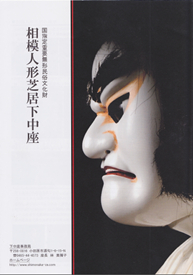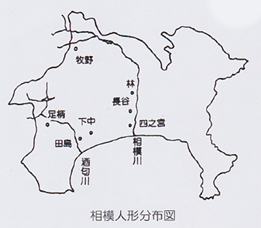

おもしろ体験博物館
江戸民具街道が紹介する足柄地域の情報
Japanese Folk Art Museum
Regional Informaiton by Edo Mingu Kaido
Home >地域情報(Local area information) >相模人形(Sagami puppet theatre)
相模人形芝居 下中座
Sagami Ningyo Shibai "Shimonaka-za Theatre"


Sagami Ningyo Shibai and
Shimonaka-za Theatre
Sagami Ningyo Shibai can be translated as Sagami Province Puppet Theatre.
During the Edo and Meiji Periods, there were puppet theatres, in which a puppet
was manipulated by three persons, in at least 15 areas along Sagami River in
Atsugi and Sakwa River in Odawara and the Koshu road in Tsukui-makino in current
Kanagawa Prefecture.
During 1951 through 1953, a research was conducted by the prefectural cultural
property committee which revealed that Shimonaka-za in Odawara City, Hayashi-za
and Hase-za in Atsugi City had traces, in their styles of puppet manipulation
and the structure of puppets, of Tokyo Nigyo Joruri that had disappeared long
ago.
Thereby the three theatrical companies were designated as intangible folk
cultural property of Kanagawa Prefecture in 1953 and national important
intangible folk cultural property by Japanese government in 1980. Two other
theatrical companies such as Sakitori-za in Hiratsuka City and Ashigara-za in
Minami-ashigara City, once disappeared during the Second World War but revived
after the war, also gained the title of prefectural intangible folk cultural
property. Currently these five theatres organize Sagami Ningyo Shibai union and
hold Sagami puppet theatre festival every year, continuing their profound
studies.

The map of Kanagawa Prefecture:
Sakawa River on the left and Sagami River in the center.
Shimonaka is located at “下中”.
History of Shimonaka-za Theatre
Shimonaka-za has nearly 300 years of history, even though the name was
officially given in 1953. Oral tradition says that a puppet theatre in this
region was initiated 290-300 years ago by puppeteers from Kyoto area who stayed
there for some time. The oldest puppet head was believed to have been made in
1751 through 1789.
At the end of the Meiji Period (around 1910), one of puppeteers from Tokyo named
Isashi Nishikawa, later called Izaemon, settled down in Odake, which brought the
prosperity to the puppet theatre. Izaemon eagerly gave lessons not only to
Shimonaka-za but to other theatrical companies such as Hase-za, Hayashi-za, and
Sakitori-za. At that time, Shimonaka-za was familiarly called “the puppet
theatre of Odake” and beloved by the local people; however, due to drastic
changes in the society by rapid economic growth after the Second World War, new
generations lost their interest in the traditional puppet show.
Facing a verge of disappearance of the theatre, Shimonaka-za had successor
training programs with cooperation extended by Odawara City; though in 1985,
Shimonaka-za for lack of members had to ask Sakitori-za for support to continue
their public performances.

Izaemon Nishikawa
New Steps Shimonaka-za Theatre is taking
In 1991, Shomonaka-za Sagami Nigyo School was established for the sake of
successor training and 17 members were newly joined in the theatre. Sagami Nigyo
Club was organized at Ninomiya High School in the neighboring town in 1980 and
students participated in national competitions 5 times and had an overseas
performance in Beijing. They have exchanges with Shimonaka-za and currently 11
members out of 33 of Shimonaka-za are the ex-club members. In 2002, Tachibana
Junior High School in Odawara City founded Sagami Ningyo Club and a special
story about the folklore “Kintaro from Mt. Ashigara” was written for students to
play, which propelled the completion of a new story titled “the birth of
Kintaro” to be performed by Shomonaka-za in 2014. (*KIntarao is also known as
Sakata-no-kinotoki, one of the big four warriors who served for
Minamonoto-no-yorimitsiu in the 10th Century, who exterminated Shutendoji, a
mythical oni leader lived in Mt. Ooe near Kyoto.) In the same year, Shimonaka-za
Club was established at Shimonaka Elementary School in Odawara City.
Shimonaka-za members give support to children while practicing twice a month on
weekends and holding public performances 15 times per year.

A scene of practice by Shimonaka-za members

Photo left: a practice scene of Shimonaka-za Club of Shimonaka Elementrary
School in the summer of 2013
Photo middle: a public performance by Sagami Ningyo Club of Tachibana Junior
High School in 2011
Photo right: members of Sagami Ningyo Club of Ninomiya High School at a national
high school cultural festival held at Toyama in 2012
相模人形芝居「下中座」ホームページ Webpage of Shimonaka-za
おもしろ体験博物館江戸民具街道
神奈川県足柄上群中井町久所418
0465-81-5339
Japanese Folk Art Museum "Edo Mingu Kaido"
Address: 418 Kuzo, Nakai-machi, Ashigara-kamigun,
Kanagawa-ken, Japan
Tel: 0465-81-5339